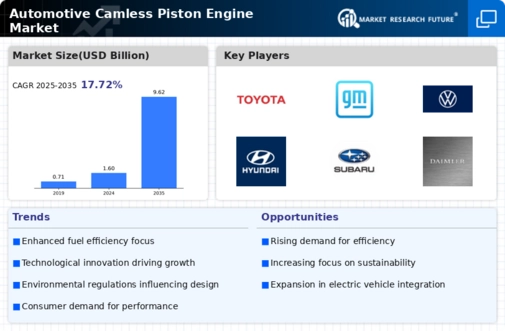Regulatory Support
Regulatory frameworks are increasingly favoring the Automotive Camless Piston Engine Market, as governments worldwide implement stricter emissions standards. These regulations compel manufacturers to adopt cleaner technologies, thereby creating a favorable environment for camless engines, which are known for their lower emissions and higher fuel efficiency. For instance, the European Union has set ambitious targets for reducing carbon emissions from vehicles, which could drive demand for camless technology. As a result, manufacturers are likely to invest more in research and development to comply with these regulations, further propelling the market forward.
Rising Fuel Prices
The Automotive Camless Piston Engine Market is also influenced by the rising fuel prices, which have prompted consumers and manufacturers to seek more fuel-efficient alternatives. As fuel costs continue to escalate, the demand for engines that offer better fuel economy becomes more pronounced. Camless piston engines, with their ability to optimize combustion and reduce fuel consumption, present a viable solution. Market analysis indicates that consumers are increasingly willing to invest in advanced engine technologies that promise long-term savings on fuel expenses, thereby driving the adoption of camless engines.
Technological Innovation
The Automotive Camless Piston Engine Market is experiencing a surge in technological innovation, which is pivotal for its growth. Advances in materials science and engineering have led to the development of lightweight and durable components, enhancing engine efficiency. Furthermore, the integration of advanced control systems allows for precise timing and operation, which can significantly improve performance metrics. According to recent data, the market for camless engines is projected to grow at a compound annual growth rate of approximately 8% over the next five years. This innovation not only boosts performance but also aligns with the industry's shift towards more efficient and environmentally friendly technologies.
Sustainability Initiatives
Sustainability initiatives are becoming increasingly critical in shaping the Automotive Camless Piston Engine Market. As environmental concerns gain traction, manufacturers are under pressure to develop engines that minimize their ecological footprint. Camless piston engines, known for their efficiency and reduced emissions, align well with these sustainability goals. Many automotive companies are now prioritizing the development of eco-friendly technologies, and camless engines are at the forefront of this movement. The market is likely to see a rise in investments aimed at enhancing the sustainability of automotive technologies, further driving the adoption of camless engines.
Consumer Demand for Performance
Consumer preferences are shifting towards high-performance vehicles, which is a significant driver for the Automotive Camless Piston Engine Market. As automotive enthusiasts seek engines that deliver superior power and responsiveness, camless technology emerges as a compelling option. The ability to fine-tune engine performance through variable valve timing and lift mechanisms appeals to a broad audience. Market Research Future suggests that the performance-oriented segment of the automotive market is expected to grow, thereby increasing the demand for innovative engine solutions like camless designs.


















Leave a Comment